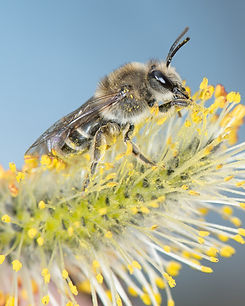
Family Apidae > Genus Triepeolus
Triepeolus
Long-horn Cuckoo Bees
In Minnesota, there are fifteen described species within the genus Triepeolus. Bees in this genus are cleptoparasitic (cuckoo bees). Their hosts include ground-nesting bees in the genera Melissodes, Eucera, Epimelissodes, and Dieunomia. A Triepeolus female enters an unoccupied host nest and lays an egg in a partially or fully provisioned brood cell. The first instar Triepeolus larva has sickle-like mandibles that it uses to kill the host egg or larva. After eliminating any competition for the provisions, the Triepeolus larva consumes the cached provisions as it develops within the brood cell. Triepeolus closely resemble bees in the genus Epeolus, and they can be difficult to tell apart. In general, Triepeolus are larger than Epeolus, but are generally medium-sized, ranging in length from 6 to 18 mm (0.25 to 0.7 inches). Epeolus have one host genus, Colletes; Triepeolus have hosts belonging to multiple genera.
Triepeolus have black integuments with white markings that are composed of scale-like flattened hairs. The legs are often but not aways red, and the rear edge of the thorax has two pointed axillae (projections). The females lack pollen-collecting structures.

A Triepeolus female visiting Heterotheca villosa.

wing
position
on flowers

N0. species in MN
15
size range

Phenology

Genus Characteristics

Small pointed axillae on middle of thorax (scutum).

Black integument with white markings (flat scale-like hairs); legs often red.

3
1
2
Three forewing submarginal cells; 2nd cell smaller than the 1st and 3rd cell.

lateral setae
pseudopygidial area
female
Female with pseudopygidial area bordered by patches of lateral setae (bristle-like hairs).
Distribution

Triepeolus concavus

Triepeolus cressonii

Triepeolus distinctus

Triepeolus donatus

Triepeolus eliseae

Triepeolus helianthi

Triepeolus lunatus

Triepeolus obliteratus

Triepeolus occidentalis

Triepeolus pectoralis

Triepeolus remigatus

Triepeolus rhododontus

Triepeolus simplex

Triepeolus subalpinus

Triepeolus tanneri
Triepeolus Species in Minnesota
Scientific Name | Host |
|---|---|
Triepeolus concavus | Epimelissodes obliqua (Rightmyer 2008) |
Triepeolus cressonii | |
Triepeolus distinctus | Dieunomia (Rightmyer 2008) |
Triepeolus donatus | |
Triepeolus eliseae | possibly Melissodes (Eumelissodes) (Gibbs 2023) |
Triepeolus helianthi | possibly Melissodes (Eumelissodes) (Gibbs 2023) |
Triepeolus lunatus | Melissodes (Rightmyer 2008) |
Triepeolus obliteratus | possibly Melissodes (Eumelissodes) (Gibbs 2023) |
Triepeolus occidentalis | Melissodes, possibly M. menuachus (Gibbs 2023) |
Triepeolus pectoralis | Melissodes druriellus (Gibbs 2023) |
Triepeolus remigatus | Xenoglossa pruinosa and Dieunomia heteropoda (Rightmyer 2008) |
Triepeolus rhododontus | |
Triepeolus simplex | |
Triepeolus subalpinus | Melissodes (Eumelissodes), possibly M. agilis (Gibbs 2023) |
Triepeolus tanneri |
Host Information: Minnesota Department of Natural Resources, Minnesota Bee Species List (August 2023).
https://files.dnr.state.mn.us/eco/mcbs/mn-statewide-bee-list.pdf
Explore More Apidae Genera
Explore Bee Families

Apidae
15 genera, 133 species
Bumble bees Bombus
Longhorn bees
Epimelissodes, Eucera, Melissodes
Carpenter bees
Ceratina, Xylocopa
Honey bees Apis
Digger bees Anthophora
Cuckoo bees Brachymelecta, Epeolus, Holcopasites, Nomada, Neolarra, Triepeolus
Squash bees Xenoglossa

2 genera, 39 species
Halictidae
10 genera, 133 species
Metallic green sweat bees
Agapostemon, Augochlora, Augochlorella, Augochloropsis
Large sweat bees
Dieunomia, Nomia
Short-faced bees Dufourea
Sweat bees Halictus
Small sweat bees Lasioglossum
Cuckoo (blood) bees Sphecodes
Megachilidae
14 genera, 86 species
Resin and pebble bees Anthidiellum, Dianthidium, Heriades, Paranthidium
Carder bees Anthidium, Pseudoanthidium
Mock orange bees Chelostoma
Mason bees Osmia, Hoplitis
Leafcutter bees Megachile
Sharp-tailed cuckoo bees Coelioxys
Dark cuckoo bees Stelis

Citations and Further Reading
Droege, S., Shumar, S., & Maffei, C. (2024). The Very Handy Bee Manual (2.0). Zenodo. https://doi.org/10.5281/zenodo.12812755
Gibbs, J., Hanuschuk, E., Miller, R., Dubois, M., Martini, M., Robinson, S., ... & Onuferko, T. M. (2023). A checklist of the bees (Hymenoptera: Apoidea) of Manitoba, Canada. The Canadian Entomologist, 155, e3.
Mitchell, T. B. (1960). Bees of the eastern United States. Technical Bulletin No. 141. North Carolina Agricultural Experiment Station.
Portman, Z. M., Gardner, J., Lane, I. G., Gerjets, N., Petersen, J. D., Ascher, J. S., ... & Cariveau, D. P. (2023). A checklist of the bees (Hymenoptera: Apoidea) of Minnesota. Zootaxa, 5304(1), 1-95.
Rightmyer, M. G. (2006). A phylogenetic analysis of the bee tribe Epeolini, with a review of the genus Triepeolus (Doctoral dissertation, University of Kansas).
Rightmyer, M. G. (2008). A review of the cleptoparasitic bee genus Triepeolus (Hymenoptera: Apidae). Part I. Zootaxa, 1710(1), 1-170.
Wilson, J. S., & Messinger Carril, O. J. (2016). The bees in your backyard: a guide to North America's bees. Princeton University Press.
Page Photography Credits
Heather Holm
Steve Mlodinow CC BY-NC 4.0 (Brachymelecta)
Michelle Orcutt CC-BY-NC 4.0 (Epimelissodes female)


















